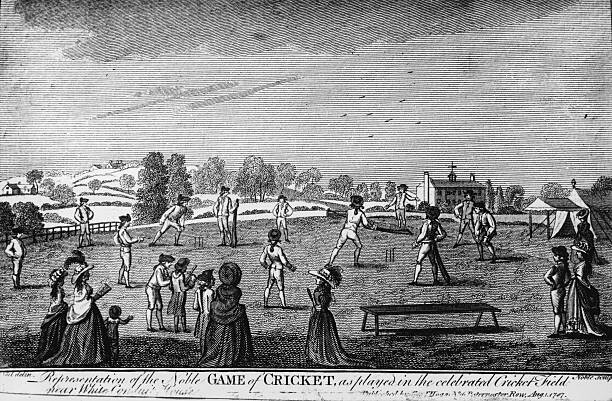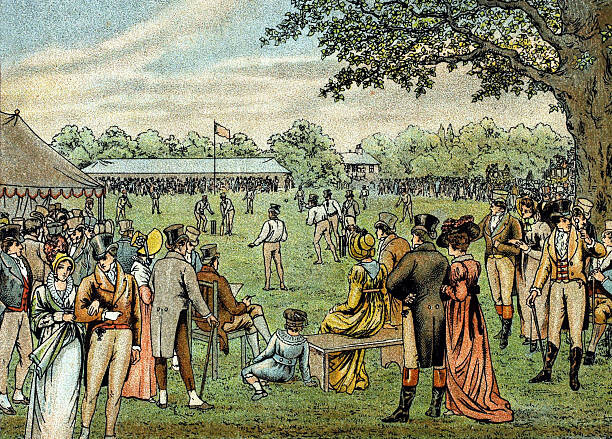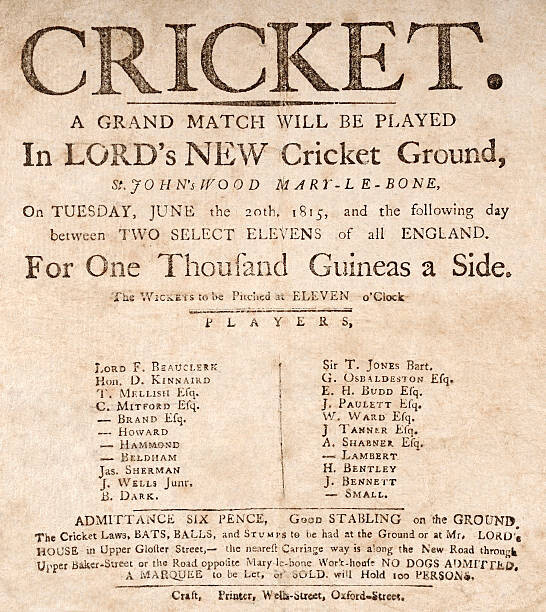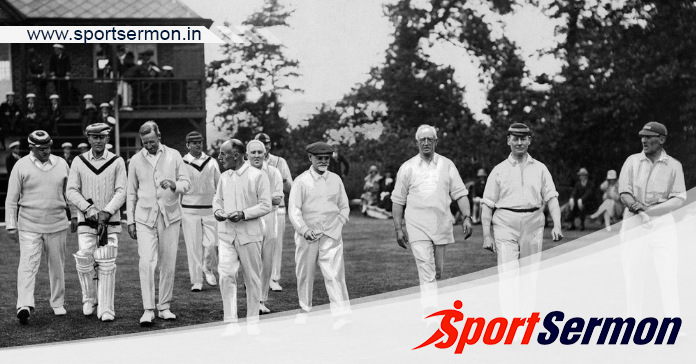The Early History of Cricket
The true roots and history of cricket, much like other sports, remain a mystery. However, some evidence says that cricket or something resembling this sport was discovered in France, leading to the possibility that cricket may have been introduced to England from France. It sheds a dim light on the history of this globally adorned sport.
Various versions of bat-and-ball games emerged across the globe, each with its own unique name and set of rules. By the late 16th century, England had a diverse range of such games, including cricket, stoolball, baseball, stickball, trapball, and more. These games were often associated with specific regions, such as cricket, which originated in the wooded areas of Kent, Surrey, and Sussex, located to the southeast of London.
The history of cricket almost streches back to 1600s. It was a game popular among Surrey schoolboys in the 1550s and was widely played by the rural population of southeastern counties in the following century. Although the peasant game had some features that we now associate with cricket, it was different from its modern counterpart in resemblance. The period is considered the beginning of the history of cricket not just because of its name, but also because of the game’s attributes.
Cricket’s Growth in England
Cricket was initially played by countrymen, and it began to get noticed only when the upper and ruling class became interested in the game in the eighteenth century that anything resembling cricket history could emerge. There are a few earlier collections of match results and scores, but no one wrote anything serious about cricket’s past until the early 1830s. John Nyren published a series of articles about his earliest memories of the game in a London magazine called The Town.
Nyren offers lively anecdotes about the Hambledon team members, their sponsors, and various rivals, as well as highlighting some of the team’s impressive wins. Later authors have compiled all the known details about the club’s matches, as well as information about its members and social events.
This project has seen an unending deluge of books concerning individual clubs and players, although many of these publications predominantly feature anecdotal nostalgia. Only a select few exceptional cricketers hold a significance that goes beyond their mere statistical records. An outstanding illustration is W. G. Grace, the physician from Bristol who asserted his dominance over English cricket during the latter part of the nineteenth century. He symbolizes the values of the emerging middle class, which were challenging the long-standing dominance of the aristocracy in the cricket.
To gain insight into the role of sports in Victorian England, it is imperative to delve into a comprehensive biography of “W. G.” A parallel example from the twentieth century is the legendary Australian batsman, Sir Donald Bradman, whose numerous biographies are prevalent in Australian cricket literature.

Cricket’s Spread to the Commonwealth
The significance of cricket in shaping a specific identities has been frequently emphasized. Victorian authors, advocates of “muscular Christianity,” firmly believed that cricket, and to some extent imparted the values of teamwork and sportsmanship to the youth. These values served as the foundation of patriotism and contributed to the positive accomplishments of the British Empire.
Sir Henry Newbolt’s poem, “Vitai Lampada,” beginning with the lines “There’s a breathless hush in the Close tonight –Ten to make and the match to win,” echoed Wellington’s renowned maxim that it was on the school cricket field that young English boys acquired the essential teamwork and self-sacrifice required for the imperial endeavor.
However, British authors aren’t the sole ones to investigate cricket’s role in forging national identity. Perhaps one of the greatest books ever penned on cricket is “Beyond A Boundary” by the West Indian Marxist historian C. L. R. James. While the book drew inspiration from a political dispute in the early 1960s regarding the leadership of the West Indian team touring Australia, it extends its scope far beyond this narrative. Instead, it offers a brilliant examination of cricket’s place within West Indian culture and politics.
James authored this work just before the West Indies team embarked on a period of remarkable success, finding a respectful position in the cricket world with widespread pride and nationalism as they triumphed in the battle over the team’s captaincy and dominated international cricket. The political implications of this victory and the subsequent decline in West Indian cricket fortunes have been further explored by Hilary McD. Beckles, who follows in James’s footsteps as a Marxist cricket writer.
The Evolution of Cricket Sport Bat Throughout the Years
Few countries have enjoyed such dedicated cricket historians, and the fact that a comprehensive account of the West Indies’ international cricket history was authored by a former Prime Minister of Jamaica, Michael Manley, underscores the game’s political significance in the islands. Nonetheless, a remarkable analysis of Indian cricket’s history can be found in Ramachandra Guha’s “A Corner of a Foreign Field: The Indian History of a British Sport.” This work intricately weaves together the intricate connections between colonialism, race, caste, religion, internal politics, and nationalism.
Comparable depth is somewhat lacking for other nations, including Australia, the reigning champions of international cricket. Even though Australia boasts Don Bradman, one of the game’s all-time greats, whose biographies shed light on the social dynamics of his era (as mentioned previously). Furthermore, there have been numerous investigations into the “body-line” controversy of 1932-33, where English fast bowlers intentionally targeted the bodies of Australian batsmen, inciting strong animosity that almost seemed to jeopardize the survival of the British Empire.
More recently, Greg Ryan’s work offers an insightful overview of the social history of cricket in New Zealand, and there are even a couple of noteworthy studies on cricket in the United States, a nation not typically associated with the sport. George Kirsch and Tom Melville explore why baseball eventually supplanted cricket as the predominant summer team sport after 1870, citing social and cultural-nationalistic factors. In doing so, particularly Melville, they illustrate how widely cricket was played in the United States before 1914, particularly among the immigrant English working class.

Cricket and National Identity
David Underdown’s “Start of Play,” the earliest chronologically, revolves around the shift from the rural game of the 17th century to the aristocracy-dominated sport of the early 19th century. It culminates in the 1830 “Captain Swing” uprisings, which erupted in the traditional cricket heartland of southeastern England, after the rural laborers felt betrayed both by their ostensible protectors in the agricultural economy and on the cricket field.
During a period in the history when capitalist farming was driving laborers into destitution, the influential aristocrats were further eroding the vitality of the rural game by recruiting the top players to London as professionals for their new Marylebone Cricket Club, famously known as the M.C.C., at Lord’s ground (named after one of cricket’s visionary entrepreneurs, Tom Lord). Underdown illustrates how the peasant and lower-middle-class game maintained its resilience at the local level throughout the 18th century, even as the M.C.C. and its forerunners tightened their grip on the sport at the national level.
The eminent individuals did not obliterate working-class cricket, even in the southeastern regions. However, after 1815, the game’s epicenter shifted towards the bustling industrial cities of the Midlands and the northern regions. In 1846, the seasoned Nottinghamshire professional, William Clarke, established a commercially successful team called the All-England Eleven.
This move aimed to provide him and his fellow professionals with a more equitable share of the game’s profits, liberating them from their status as poorly compensated dependents of the county clubs run by the gentry. It exemplified the quintessential spirit of Victorian entrepreneurship but inevitably triggered an enduring conflict with the aristocratic establishment at the M.C.C.
Cricket’s Impact on English Culture and Society
This particular era in English cricket history is extensively documented in works like Birley’s and other comprehensive histories, including Christopher Brookes’ writings and the introductory sections of Keith A. P. Sandiford’s “Cricket and the Victorians.” However, Sandiford’s primary focus lies in the period post-1870, when a unique blend of amateurism and professionalism gave rise to the primary domestic competition, the County Championship, along with the inception of “Test” (international) cricket.
Sandiford delves into the class dynamics that this era entailed, scrutinizing the financial arrangements (unfortunately, quite meager for the professionals) that sustained it. He also offers a valuable exploration of the ideology of “muscular Christianity,” which played a role in indoctrinating youthful cricketers with Victorian values and the ideals of the Empire. He keenly observes the often concealed motives of these cricketers: to amass wealth, to cultivate a reputation for virtue and teamwork, and to advance the interests of their class, race, or community.
Undoubtedly, these motivations were genuine, but it’s important not to overlook the fact that they were also deriving enjoyment from their endeavors. Regarding club (local) cricket, Sandiford appears more at ease when discussing the northern leagues, where financial stakes were most overtly apparent, than with the extensive recreational cricket still flourishing in the southern towns and villages.

A New Dimension of Cricket as a Recognised Sport
Cricket has consistently mirrors societal realities throughout its history, and it’s unsurprising that in the latter part of the 20th century, the game’s traditional aristocratic and gentry leaders have been supplanted by representatives from the corporate and financial sectors. Simultaneously, the scheduling and presentation of matches have increasingly been influenced by the demands of television, which plays a pivotal role in cricket sponsorship.
One of the harshest critiques of the cricket establishment comes from an American convert to the game, Mike Marqusee. His polemical work, “Anyone But England,” engagingly delves into some of the historical factors underpinning the rather disheartening condition of English cricket, particularly at the international level in the early 1990s. According to Marqusee, to comprehend this situation, we must examine the entire history of the sport, which curiously parallels the nation’s history over the past two centuries.
Marqusee points out that modern Britain has largely been shaped by the interplay of two significant socio-cultural forces: the traditionalism of the rural, landed aristocracy and the commercialism of an expanding middle class. Over time, these two forces started to merge, as middle-class financiers and industrialists purchased their way into the landed sector. Whether consciously or unconsciously, they adopted aristocratic myths and illusions to mask the fact that their influence fundamentally rested on wealth.
Conversely, the longstanding aristocracy and gentry preserved their economic standing (which became increasingly threatened due to the agricultural depression of the late 19th century) by forming alliances with their commercially minded counterparts.
They provided respectability by accepting directorships in their companies, forming matrimonial ties, and bestowing upon them the prestigious symbols of rural leadership, such as Lord Lieutenant or Justice of the Peace. They even welcomed them onto committees that oversaw county cricket clubs and the M.C.C. itself.
The Battle of Traditionalism vs Modernism in Cricket
According to Marqusee, English cricket history has consistently grappled with a conflict between those upholding traditional British beliefs in the superiority of upper-class leadership and the presumption of Britain’s enduring status as a great power, and those advocating a complete departure from cricket’s traditions in favor of aligning with the corporate sector. After the disastrous home series against Australia in 1993, Marqusee notes that the selectors of the England team appeared paralyzed, mirroring what he considers the Major government’s stance on the country’s economic challenges.
Until the 1980s, the traditionalists still retained some influence within the M.C.C., but it was in that decade that the “money-men” of the new Test and County Cricket Board assumed full control. Marqusee exemplifies the manifestation of this conflict through various contentious episodes, often echoing the historical struggle between amateurism and professionalism.
These included the clash with Australian TV tycoon Kerry Packer in the late 1970s, the acrimonious dispute regarding boycotting South Africa during the Apartheid era, and the recurrent racially charged disputes with Pakistan concerning umpiring and interpretation of the Laws.
Both the traditionalists and the “money-men” held shared misconceptions about the inherent rights of English cricketers to exert dominance over their global counterparts in their own interests. Marqusee repeatedly emphasizes that this antiquated cricket mindset has always thrived in what he describes as “the decaying legacy of empire.”
Examining class dynamics within cricket inevitably leads us to considerations of financial rewards and economic aspects. By the 1740s, cricket had already become an integral part of the “leisure revolution,” where urban residents from various social strata sought affordable forms of entertainment. Notably, cricket became one of the first team sports that introduced admission fees for certain significant matches.
In London, the epicenter of commercial cricket was the Artillery Ground in Finsbury, overseen by George Smith, one of cricket’s early impresarios, who also managed a nearby establishment, The Pied Horse, which thrived on match days. Smith secured aristocratic sponsors to support the matches, charging entrance fees similar to those at popular music halls. For significant matches, the Artillery Ground attracted sizable crowds, with estimates ranging from around 8,000 to 10,000 attendees.
Conversely, major rural contests, such as those involving Hambledon, typically took place on extensive commons like Broadhalfpenny Down, where admission fees couldn’t be imposed. However, this presented lucrative opportunities for publicans and victuallers who supplied food and beverages to the eager and thirsty crowds.

Professionalism & Commercialism in Cricket
The rise of professionalism in cricket was intimately linked to the growing emphasis placed by both players and promoters on the monetary aspects of the game. Gambling had always been a part of the English way of life, spanning all social classes, and it found its way into cricket from its earliest days. It is relatively a new development in the history of cricket.
However, it appears that neither the relatively small stakes, often just a shilling or so, in village matches nor the substantial wagers made by aristocratic patrons in the matches they supported led to significant corruption until the centralization of major games at Lord’s around 1800. This exposed players to tempting offers from professional bookmakers who were more than willing to bribe them to intentionally lose matches.
A valuable source of insight into this period can be found in the work of an enthusiastic cricket-loving clergyman, the Reverend James Pycroft, published in 1851. Among other things, Pycroft’s work can be seen as one of the earliest attempts to compile oral history based on interviews with old cricketers. Notably, “Silver Billy” Beldham, one of the most renowned figures, provided a wealth of information regarding match-fixing scandals around 1800.
Consequently, several leading professionals faced bans from playing at Lord’s during this time. Nevertheless, for a significant period, amateurs like Lord Frederick Beauclerk continued to supplement their incomes through betting, often on matches in which they themselves participated. Somehow, after the mid-1820s, the M.C.C. managed to cleanse the game’s integrity at Lord’s, and the club’s formidable reputation largely curbed the most egregious forms of corruption for nearly two centuries.
Around the year 2000, cricket was rocked by another series of scandals when South African captain Hansie Cronje was discovered to have accepted bribes from bookmakers in exchange for manipulating his own team’s matches against India. Subsequently, players from various countries faced similar allegations, resulting in several bans from international cricket. While, at the time of writing, no definitive analysis of these scandals has emerged, it’s reasonable to anticipate that one will be published in the not-too-distant future. It’s evident that cricket, like any other sport, is not immune to the allure of money.

